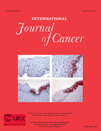Kaposi's sarcoma risk among transplant recipients in the United States (1993–2003)†
The content is the responsibility of the authors alone and does not necessarily reflect the views or policies of the Department of Health and Human Services.
Abstract
Kaposi's sarcoma (KS) risk is high in immunosuppressed transplant recipients. KS develops in recipients with pre-existing infection with human herpesvirus 8 (HHV-8), the causative agent for KS, but it can also occur in recipients infected by donors. The relative importance of these sources of infection in recipients in the United States is unknown. We report recipient and donor characteristics associated with KS among transplant recipients in the United States. KS risk, after solid organ transplantation during 1993–2003, was analyzed using data from the Organ Procurement and Tissue Network. Associations were determined using proportional hazards regression. Sixtyfive KS cases were identified among 234,127 transplants (incidence 8.8 per 100,000 person-years). Most cases occurred in the first 2 years after transplantation (incidence 12.5 per 100,000 person-years). KS risk increased steadily with recipient age (ptrend < 0.001) and was associated with the recipient being male (HR 1.8, 95% CI, 1.0–3.2), Hispanic (2.1, 1.1–3.8) and a non-U.S. citizen (3.9, 1.8–8.6). Mismatch at the HLA-B locus, but not at HLA-A or HLA-DR loci, was associated with heightened risk (HR 3.6, 95%CI 1.1–11 for 1–2 vs. 0 HLA-B mismatches). KS was unrelated to donor characteristics and was not significantly related to use of specific antirejection medications. Our study found that KS incidence was low among transplant recipients in the United States, but it was associated with recipient age, sex and citizenship, perhaps reflecting pre-existing HHV-8 infection. The high KS risk immediately posttransplant and in persons with HLA-B mismatch highlights the role of immunosuppression and/or immune stimulation in KS pathogenesis. © 2006 Wiley-Liss, Inc.




